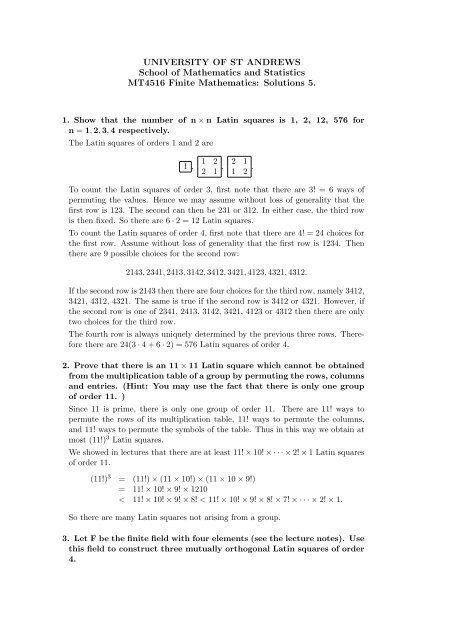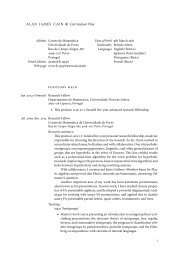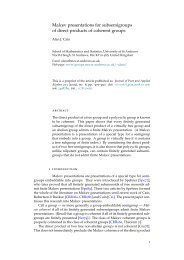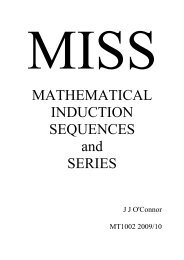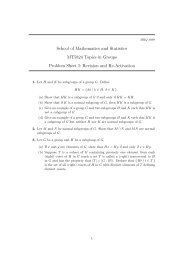Solutions 5. - University of St Andrews
Solutions 5. - University of St Andrews
Solutions 5. - University of St Andrews
Create successful ePaper yourself
Turn your PDF publications into a flip-book with our unique Google optimized e-Paper software.
UNIVERSITY OF ST ANDREWS<br />
School <strong>of</strong> Mathematics and <strong>St</strong>atistics<br />
MT4516 Finite Mathematics: <strong>Solutions</strong> <strong>5.</strong><br />
1. Show that the number <strong>of</strong> n × n Latin squares is 1, 2, 12, 576 for<br />
n = 1, 2, 3, 4 respectively.<br />
The Latin squares <strong>of</strong> orders 1 and 2 are<br />
1 ,<br />
1 2<br />
2 1 , 2 1<br />
1 2 .<br />
To count the Latin squares <strong>of</strong> order 3, first note that there are 3! = 6 ways <strong>of</strong><br />
permuting the values. Hence we may assume without loss <strong>of</strong> generality that the<br />
first row is 123. The second can then be 231 or 312. In either case, the third row<br />
is then fixed. So there are 6 · 2 = 12 Latin squares.<br />
To count the Latin squares <strong>of</strong> order 4, first note that there are 4! = 24 choices for<br />
the first row. Assume without loss <strong>of</strong> generality that the first row is 1234. Then<br />
there are 9 possible choices for the second row:<br />
2143, 2341, 2413, 3142, 3412, 3421, 4123, 4321, 4312.<br />
If the second row is 2143 then there are four choices for the third row, namely 3412,<br />
3421, 4312, 4321. The same is true if the second row is 3412 or 4321. However, if<br />
the second row is one <strong>of</strong> 2341, 2413, 3142, 3421, 4123 or 4312 then there are only<br />
two choices for the third row.<br />
The fourth row is always uniquely determined by the previous three rows. Therefore<br />
there are 24(3 · 4 + 6 · 2) = 576 Latin squares <strong>of</strong> order 4.<br />
2. Prove that there is an 11 × 11 Latin square which cannot be obtained<br />
from the multiplication table <strong>of</strong> a group by permuting the rows, columns<br />
and entries. (Hint: You may use the fact that there is only one group<br />
<strong>of</strong> order 11. )<br />
Since 11 is prime, there is only one group <strong>of</strong> order 11. There are 11! ways to<br />
permute the rows <strong>of</strong> its multiplication table, 11! ways to permute the columns,<br />
and 11! ways to permute the symbols <strong>of</strong> the table. Thus in this way we obtain at<br />
most (11!) 3 Latin squares.<br />
We showed in lectures that there are at least 11! × 10! × · · · × 2! × 1 Latin squares<br />
<strong>of</strong> order 11.<br />
(11!) 3 = (11!) × (11 × 10!) × (11 × 10 × 9!)<br />
= 11! × 10! × 9! × 1210<br />
< 11! × 10! × 9! × 8! < 11! × 10! × 9! × 8! × 7! × · · · × 2! × 1.<br />
So there are many Latin squares not arising from a group.<br />
3. Let F be the finite field with four elements (see the lecture notes). Use<br />
this field to construct three mutually orthogonal Latin squares <strong>of</strong> order<br />
4.
Recall that the addition and multiplication tables for F are:<br />
+ 0 1 x x + 1<br />
0 0 1 x x + 1<br />
1 1 0 x + 1 x<br />
x x x + 1 0 1<br />
x + 1 x + 1 x 1 0<br />
× 0 1 x x + 1<br />
0 0 0 0 0<br />
1 0 1 x x + 1<br />
x 0 x x + 1 1<br />
x + 1 0 x + 1 1 x<br />
Let f 1 = 1, f 2 = x, f 3 = x + 1 and f 4 = 0. The formula for the squares<br />
A k = (a (k)<br />
ij ) 4×4, for k = 1, 2, 3 is a (k)<br />
ij<br />
= f i f k + f j .<br />
So a (1)<br />
ij<br />
= f i + f j .<br />
a (2)<br />
ij<br />
= f i · x + f j .<br />
a (3)<br />
ij<br />
= f i · (x + 1) + f j .<br />
After renaming the symbols:<br />
A 1 =<br />
1 x 1 + x 0<br />
1 0 x + 1 x 1<br />
x x + 1 0 1 x<br />
1 + x x 1 0 x + 1<br />
0 1 x x + 1 0<br />
f i xf i 1 x 1 + x 0<br />
1 x 1 + x 0 1 x<br />
x x + 1 x 1 0 x + 1<br />
x + 1 1 0 x + 1 x 1<br />
0 0 1 x x + 1 0<br />
4 3 2 1<br />
3 4 1 2<br />
2 1 4 3<br />
1 2 3 4<br />
f i (x + 1)f i 1 x x + 1 0<br />
1 x + 1 x 1 0 x + 1<br />
x 1 0 x + 1 x 1<br />
x + 1 x x + 1 0 1 x<br />
0 0 1 x x + 1 0<br />
, A 2 =<br />
3 4 1 2<br />
2 1 4 3<br />
4 3 2 1<br />
1 2 3 4<br />
, A 3 =<br />
2 1 4 3<br />
4 3 2 1<br />
3 4 1 2<br />
1 2 3 4<br />
4. Prove that there is no Latin square orthogonal to the square<br />
A =<br />
1 2 3 4<br />
2 4 1 3<br />
3 1 4 2<br />
4 3 2 1<br />
Assume that B = (b ij ) 4×4 is orthogonal to A. We may assume without loss <strong>of</strong><br />
generality that B is in standard form, so that b 11 = 1, b 12 = 2, b 13 = 3, b 14 = 4.<br />
There are two possible choices for b 21 : either b 21 = 3 or b 21 = 4 since (a 12 , b 12 ) =<br />
(2, 2). If b 21 = 3 then we deduce that b 22 = 1, b 24 = 2, b 23 = 4, b 31 = 4, b 32 = 3,<br />
b 33 = 2, b 34 = 1. After this there is no possibility for b 41 .<br />
If b 21 = 4 then b 31 = 2, b 41 = 3, b 23 = 2 and then there is no possible value for b 44 .<br />
<strong>5.</strong> Construct two orthogonal Latin squares <strong>of</strong> order 12. (Hint: Use direct<br />
products.)<br />
.<br />
.
Take two orthogonal Latin squares <strong>of</strong> order 4, say A 1 and A 2 from Q3, and two<br />
orthogonal Latin squares <strong>of</strong> order 3, say<br />
The direct products are:<br />
B =<br />
1 2 3<br />
2 3 1<br />
3 1 2<br />
, C =<br />
1 2 3<br />
3 1 2<br />
2 3 1<br />
.<br />
A 1 ×B =<br />
B 4 B 3 B 2 B 1<br />
B 3 B 4 B 1 B 2<br />
=<br />
B 2 B 1 B 4 B 3<br />
B 1 B 2 B 3 B 4<br />
10 11 12 7 8 9 4 5 6 1 2 3<br />
11 12 10 8 9 7 5 6 4 2 3 1<br />
12 10 11 9 7 8 6 4 5 3 1 2<br />
7 8 9 10 11 12 1 2 3 4 5 6<br />
8 9 7 11 12 10 2 3 1 5 6 4<br />
9 7 8 12 10 11 3 1 2 6 4 5<br />
4 5 6 1 2 3 10 11 12 7 8 9<br />
5 6 4 2 3 1 11 12 10 8 9 7<br />
6 4 5 3 1 2 12 10 11 9 7 8<br />
1 2 3 4 5 6 7 8 9 10 11 12<br />
2 3 1 5 6 4 8 9 7 11 12 10<br />
3 1 2 6 4 5 9 7 8 12 10 11<br />
A 2 ×C =<br />
C 3 C 4 C 1 C 2<br />
C 2 C 1 C 4 C 3<br />
=<br />
C 4 C 3 C 2 C 1<br />
C 1 C 2 C 3 C 4<br />
These are orthogonal Latin squares <strong>of</strong> order 12.<br />
7 8 9 10 11 12 1 2 3 4 5 6<br />
9 7 8 12 10 11 3 1 2 6 4 5<br />
8 9 7 11 12 10 2 3 1 5 6 4<br />
4 5 6 1 2 3 10 11 12 7 8 9<br />
6 4 5 3 1 2 12 10 11 9 7 8<br />
5 6 4 2 3 1 11 12 10 8 9 7<br />
10 11 12 7 8 9 4 5 6 1 2 3<br />
12 10 11 9 7 8 6 4 5 3 1 2<br />
11 12 10 8 9 7 5 6 4 2 3 1<br />
1 2 3 4 5 6 7 8 9 10 11 12<br />
3 1 2 6 4 5 9 7 8 12 10 11<br />
2 3 1 5 6 4 8 9 7 11 12 10<br />
6. A Latin square is said to be self-orthogonal if it is orthogonal to its<br />
own transpose.<br />
We let A T = (b ij ) n×n where b ij = a ji .<br />
(i) Prove that if A = (a ij ) n×n is a self-orthogonal Latin square then all<br />
the entries a ii , 1 ≤ i ≤ n, are distinct.<br />
If a ii = a jj then (a ii , b ii ) = (a ii , a ii ) = (a jj , a jj ) = (a jj , b jj ), which contradicts<br />
self-orthogonality.<br />
(ii) Prove that there are no self-orthogonal Latin squares <strong>of</strong> order 3;<br />
find a self orthogonal Latin square <strong>of</strong> order 4.<br />
Assume that A = (a ij ) 3×3 is self-orthogonal. By permuting the symbols if<br />
necessary, we may assume without loss <strong>of</strong> generality that a 11 = 1, a 12 = 2<br />
.
and a 13 = 3. From part (i) it then follows that a 22 = 3 and a 33 = 2. But then<br />
there is no possibility for a 21 , since a 11 = 1 so a 21 ≠ 1, a 12 = 2 so a 21 ≠ 2<br />
and a 22 = 3 so a 21 ≠ 3.<br />
We use similar arguments to construct the following self-orthogonal Latin<br />
square <strong>of</strong> order 4:<br />
1 2 3 4<br />
4 3 2 1<br />
.<br />
2 1 4 3<br />
3 4 1 2<br />
(iii) Prove that the direct product <strong>of</strong> two self-orthogonal Latin squares is<br />
again a self-orthogonal Latin square. (Hint: You may use (A × B) T = A T × B T ).<br />
If A is orthogonal to A T and if B is orthogonal to B T then A×B is orthogonal<br />
to A T × B T = (A × B) T .<br />
(iv) Let n > 3 be a prime power, and let F = {f 1 , f 2 , . . . , f n } be the finite<br />
field with n elements. For an arbitrary t ∈ F, with t ≠ 0, 1 and<br />
t + t ≠ 1, define an array A t = (a ij ) n×n by a (t)<br />
ij<br />
= tf i + (1 − t)f j . Prove<br />
that A t is a self orthogonal Latin square.<br />
First we show that A t is a Latin square. If a (t)<br />
ij<br />
= a (t)<br />
ik<br />
then<br />
tf i + (1 − t)f j = tf i + (1 − t)f k<br />
so (1 − t)f j = (1 − t)f k and hence f j = f k and so j = k. So there are no<br />
repeats in any row.<br />
If a (t)<br />
ij<br />
= a (t)<br />
kj then<br />
tf i + (1 − t)f j = tf k + (1 − t)f j<br />
so tf i = tf k and hence f i = f k and i = k. So there are no repeats in any<br />
column and A t is a Latin square.<br />
Now we show that A t is self-orthogonal. Suppose that (a (t)<br />
ij , a(t) ji ) = (a(t)<br />
Then<br />
Equation (1) implies that<br />
Substituting into (2) we get:<br />
tf i + (1 − t)f j = tf k + (1 − t)f l (1)<br />
tf j + (1 − t)f i = tf l + (1 − t)f k (2)<br />
f i = t −1 (tf k + (1 − t)f l + (t − 1)f j )<br />
= f k + t −1 (1 − t)f l + t −1 (t − 1)f j .<br />
kl , a(t) lk ).<br />
tf j + f k + t −1 (1 − t)f l + t −1 (t − 1)f j − tf k − (1 − t)f l − (t − 1)f j = tf l + (1 − t)f k<br />
⇒ f j (t + 1 − t −1 − t + 1) = f l (1 − t −1 − t + 1 + t)<br />
⇒ f j (2 − t −1 ) = f l (2 − t −1 )<br />
⇒ f j (2t − 1) = f l (2t − 1).<br />
Since 2t ≠ 1 we deduce that f j = f l . Then (1) ⇒ f i = f k . So i = k and j = l.


